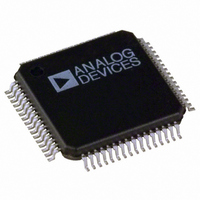ADAV801ASTZ Analog Devices Inc, ADAV801ASTZ Datasheet - Page 24

ADAV801ASTZ
Manufacturer Part Number
ADAV801ASTZ
Description
IC CODEC AUDIO R-DVD 3.3V 64LQFP
Manufacturer
Analog Devices Inc
Type
Audio Codecr
Datasheet
1.ADAV801ASTZ-REEL.pdf
(60 pages)
Specifications of ADAV801ASTZ
Data Interface
Serial
Resolution (bits)
24 b
Number Of Adcs / Dacs
2 / 2
Sigma Delta
No
Dynamic Range, Adcs / Dacs (db) Typ
102 / 101
Voltage - Supply, Analog
3 V ~ 3.6 V
Voltage - Supply, Digital
3 V ~ 3.6 V
Operating Temperature
-40°C ~ 85°C
Mounting Type
Surface Mount
Package / Case
64-LQFP
Audio Codec Type
Stereo
No. Of Adcs
2
No. Of Dacs
2
No. Of Input Channels
2
No. Of Output Channels
2
Adc / Dac Resolution
24bit
Adcs / Dacs Signal To Noise Ratio
102dB
Single Supply Voltage (typ)
3.3V
Single Supply Voltage (min)
3V
Single Supply Voltage (max)
3.6V
Package Type
LQFP
Adc/dac Resolution
24b
Interface Type
Serial (SPI)
Mounting
Surface Mount
Number Of Adc's
2
Number Of Dac's
2
Operating Supply Voltage (max)
3.6V
Operating Supply Voltage (min)
3V
Operating Supply Voltage (typ)
3.3V
Operating Temperature (max)
85C
Operating Temperature (min)
-40C
Pin Count
64
Power Supply Type
Analog/Digital
Sample Rate
96KSPS
Screening Level
Industrial
Lead Free Status / RoHS Status
Lead free / RoHS Compliant
For Use With
EVAL-ADAV801EBZ - BOARD EVALUATION FOR ADAV801
Lead Free Status / Rohs Status
Compliant
Available stocks
Company
Part Number
Manufacturer
Quantity
Price
Company:
Part Number:
ADAV801ASTZ
Manufacturer:
ADI
Quantity:
455
Company:
Part Number:
ADAV801ASTZ
Manufacturer:
Analog Devices Inc
Quantity:
10 000
Part Number:
ADAV801ASTZ
Manufacturer:
ADI/亚德诺
Quantity:
20 000
Company:
Part Number:
ADAV801ASTZ-REEL
Manufacturer:
Analog Devices Inc
Quantity:
10 000
ADAV801
Serial Digital Audio Transmission Standards
The ADAV801 can receive and transmit S/PDIF, AES/EBU, and
IEC-958 serial streams. S/PDIF is a consumer audio standard,
and AES/EBU is a professional audio standard. IEC-958 has
both consumer and professional definitions. This data sheet is
not intended to fully define or to provide a tutorial for these
standards. Contact the international standards-setting bodies
for the full specifications.
All these digital audio communication schemes encode audio
data and audio control information using the biphase-mark
method. This encoding method minimizes the dc content of the
transmitted signal. As can be seen from Figure 43, 1s in the
original data end up with midcell transitions in the biphase-
mark encoded data, while 0s in the original data do not. Note
that the biphase-mark encoded data always has a transition
between bit boundaries.
Digital audio-communication schemes use preambles to
distinguish among channels (called subframes) and among
longer-term control information blocks (called frames). Pream-
bles are particular biphase-mark patterns, which contain encoding
violations that allow the receiver to uniquely recognize them.
These patterns and their relationship to frames and subframes
are shown in Table 8 and Figure 44.
Table 8. Biphase-Mark Encode Preamble
X
Y
Z
The biphase-mark encoding violations are shown in Figure 45.
Note that all three preambles include encoding violations.
Ordinarily, the biphase-mark encoding method results in a
polarity transition between bit boundaries.
(2 TIMES BIT RATE)
X
LEFT CH
BIPHASE-MARK
Biphase Patterns
11100010 or 00011101
11100100 or 00011011
11101000 or 00010111
FRAME 191
CLOCK
Y
DATA
DATA
RIGHT CH
Figure 44. Preambles, Frames, and Subframes
Figure 43. Biphase-Mark Encoding
Z
SUBFRAME
0
LEFT CH
PREAMBLES
FRAME 0
1
Y
SUBFRAME
RIGHT CH
1
Channel
Left
Right
Left and CS block start
X
1
LEFT CH
FRAME 1
0
Y
RIGHT CH
0
Rev. A | Page 24 of 60
The serial digital audio communication scheme is organized
using a frame and subframe construction. There are two
subframes per frame (ordinarily the left and right channel).
Each subframe includes the appropriate 4-bit preamble, up to
24 bits of audio data, a validity (V) bit, a user (U) bit, a channel
status (C) bit, and an even parity (P) bit. The channel status bits
and the user bits accumulate over many frames to convey
control information. The channel status bits accumulate over a
192 frame period (called a channel status block). The user bits
accumulate over 1176 frames when the interconnect is imple-
menting the so-called subcode scheme (EIAJ CP-2401). The
organization of the channel status block, frames, and subframes
is shown in Table 9 and Table 10. Note that the ADAV801
supports the professional audio standard from a software
point of view only. The digital interface supports only
consumer mode.
Table 9. Consumer Audio Standard
Address
N
N + 1
N + 2
N + 3
N + 4
N + 5 to
(N + 23)
1
N = 0x20 for receiver channel status buffer.
N = 0x38 for transmitter channel status buffer.
PREAMBLE X
PREAMBLE Y
PREAMBLE Z
1
7
Reserved
Channel
Status
Channel Number
6
Reserved
1
1
1
Figure 45. Preambles
5
Accuracy
1
1
1
Clock
Emphasis
1
1
1
Category Code
4
Data Bits
Reserved
0
0
0
0
0
1
3
Sampling Frequency
0
1
0
2
Copy-
right
Source Number
1
0
0
Word Length
0
0
0
1
Non-
Audio
0
Pro/
Con
= 0













